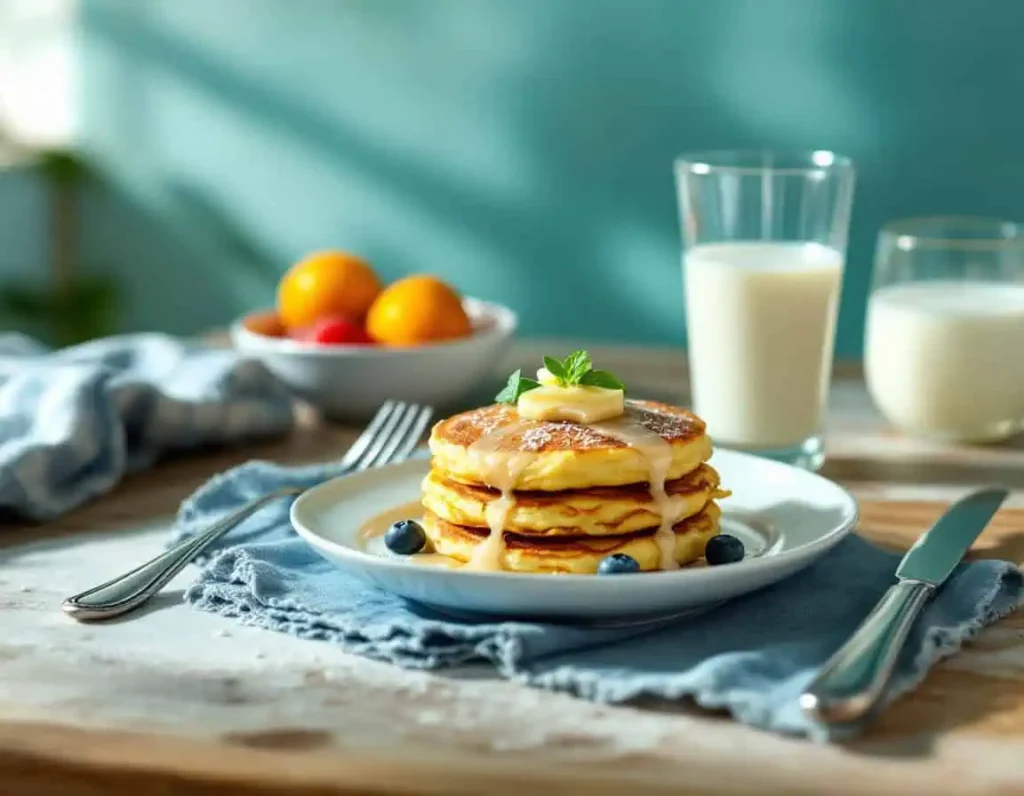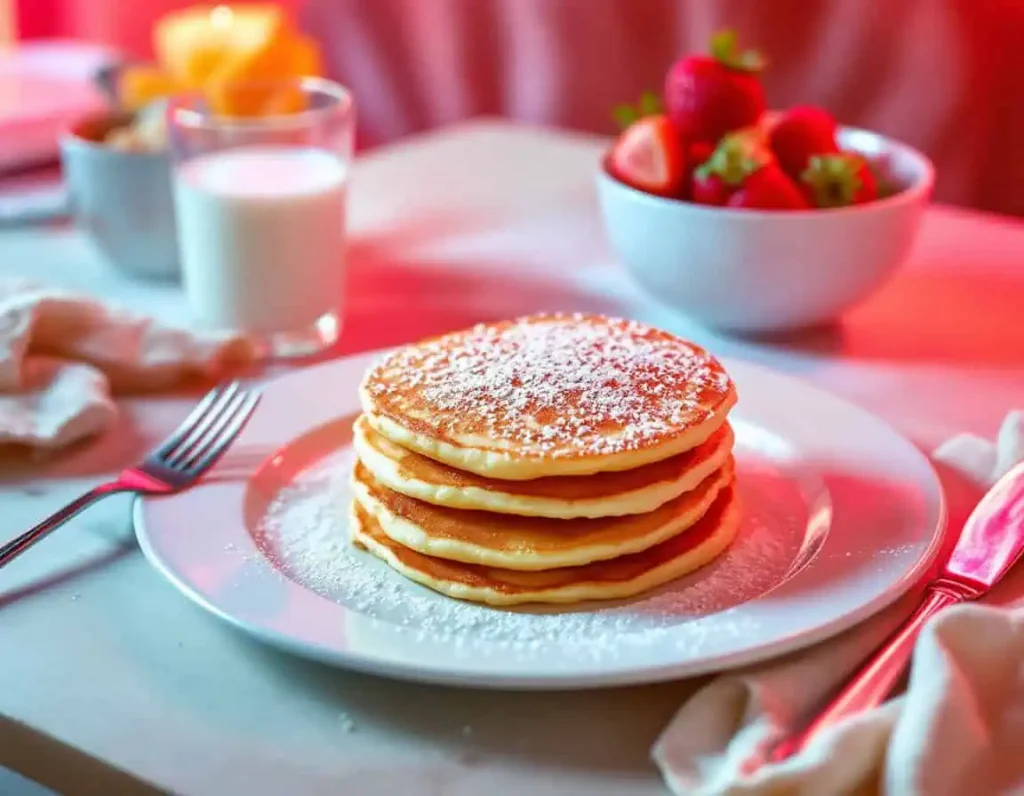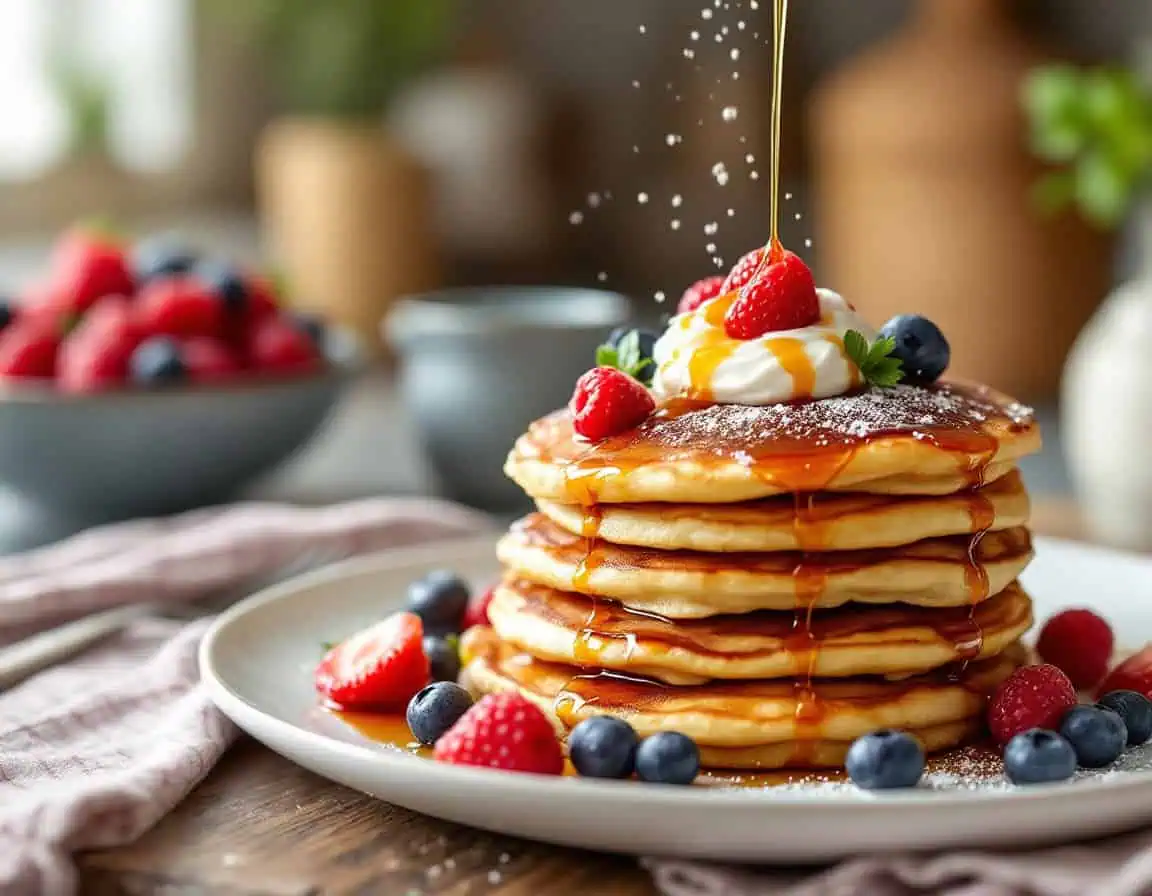Kodiak cakes have become increasingly popular among health-conscious breakfast enthusiasts, but one question continues to spark debate: are Kodiak cakes better with water or milk? In this comprehensive guide, we will explore the nutritional aspects, texture differences, and preparation tips for both methods. We’ll also delve into creative variations, common mistakes to avoid, and answer frequently asked questions to help you make the best choice for your morning pancakes.
Understanding Kodiak Cakes Basics
What Makes Kodiak Cakes Different?
Kodiak Cakes Power Cakes stand out from traditional pancake mixes because of their:
- Higher protein content: With a focus on whole grains and protein, Kodiak Cakes provide a nutritious start to your day.
- Whole grain ingredients: Made with 100% whole grains, they offer more fiber and nutrients than regular pancake mixes.
- Natural sweeteners: Kodiak Cakes use natural sweeteners, making them a healthier option for those looking to reduce refined sugar intake.
- Versatile preparation options: Whether you prefer pancakes, waffles, or even muffins, Kodiak Cakes can be adapted to suit your needs.
Water vs. Milk in Kodiak Cakes: The Ultimate Comparison
Texture Differences
When preparing Kodiak Cakes with water, you can expect:
- Lighter consistency: Water creates a thinner batter, resulting in pancakes that are less dense.
- Thinner batter: This can lead to a more traditional pancake texture, which some people prefer.
- More traditional pancake texture: The end result is often a pancake that resembles those made from standard mixes.
Using milk results in:
- Richer, creamier texture: Milk adds fat and creaminess, enhancing the overall mouthfeel.
- Fluffier pancakes: The proteins in milk can help create a fluffier pancake, making them more satisfying.
- More substantial mouthfeel: The added richness can make the pancakes feel more indulgent.
Nutritional Impact
Water-Based Preparation
Using water to prepare Kodiak Cakes has several nutritional benefits:
- Fewer calories: Water has no calories, making it an excellent choice for those watching their caloric intake.
- Lower fat content: Since water contains no fat, your pancakes will be lower in overall fat.
- Maintains original protein content: The protein content from the mix remains unchanged, providing a healthy breakfast option.
- Perfect for calorie-conscious individuals: If you’re looking to enjoy pancakes without the extra calories, water is the way to go.
Milk-Based Preparation
On the other hand, using milk can enhance the nutritional profile of your pancakes:
- Additional protein boost: Milk adds extra protein, which can help keep you feeling full longer.
- Extra calcium: Dairy milk is a great source of calcium, essential for bone health.
- More vitamins and minerals: Milk contains various vitamins and minerals, including vitamin D and B vitamins, which can enhance the overall nutritional value of your meal.
- Enhanced nutritional profile: Overall, using milk can make your pancakes more nutrient-dense, which is beneficial for those looking to maximize their breakfast.
Best Milk Options for Kodiak Cakes
When deciding to use milk in your Kodiak Cakes, you have several options. Each type of milk can affect the flavor, texture, and nutritional content of your pancakes.
Dairy Milk Varieties
- Whole Milk
- Richest texture: Whole milk provides the creamiest texture, making your pancakes feel more indulgent.
- Highest calorie option: If you’re not concerned about calories, whole milk is a great choice.
- Maximum flavor enhancement: The fat in whole milk enhances the overall flavor of the pancakes.
- 2% Milk
- Balanced option: 2% milk offers a good balance between creaminess and calorie content.
- Moderate calorie addition: It adds some calories but not as much as whole milk.
- Good protein boost: It still provides a decent amount of protein without being too heavy.
- Skim Milk
- Lowest calorie dairy option: Skim milk is the best choice for those looking to minimize calorie intake.
- Still provides protein benefits: While lower in fat, it still offers a good amount of protein.
- Lighter texture than whole milk: The pancakes will be less rich but still enjoyable.
Plant-Based Alternatives
If you prefer non-dairy options, there are several plant-based milks to consider:
- Almond Milk
- Low-calorie option: Almond milk is typically lower in calories than dairy milk.
- Subtle nutty flavor: It adds a slight nuttiness to your pancakes, which can be delightful.
- Less protein than dairy milk: Keep in mind that almond milk has significantly less protein.
- Soy Milk
- Highest protein content among plant-based options: Soy milk is a great alternative for those looking for a protein boost.
- Neutral taste: It has a mild flavor that won’t overpower the taste of your pancakes.
- Similar texture to dairy milk: It can create a similar texture to pancakes made with cow’s milk.
- Oat Milk
- Creamy texture: Oat milk is known for its creamy consistency, making it a great choice for pancakes.
- Natural sweetness: It has a naturally sweet flavor that can enhance the taste of your pancakes.
- Compatible with whole grain flavors: Oat milk pairs well with the whole grain ingredients in Kodiak Cakes.

Expert Tips for Perfect Kodiak Cakes
Water-Based Preparation Tips
If you decide to use water for your Kodiak Cakes, here are some tips to ensure the best results:
- Use the exact recommended amount of water: Follow the instructions on the package for the best consistency.
- Let batter rest for 2-3 minutes before cooking: This allows the ingredients to hydrate properly, resulting in better texture.
- Ensure proper griddle temperature (350°F): Preheat your griddle to the right temperature to achieve even cooking.
Milk-Based Preparation Tips
For those opting for milk, consider these tips:
- Reduce milk slightly compared to water measurements: Milk is denser than water, so you may need a little less to achieve the desired consistency.
- Watch cooking time (milk-based pancakes may cook slower): Keep an eye on your pancakes, as they may take a bit longer to cook through.
- Adjust heat slightly lower to prevent burning: Since milk can caramelize quickly, lowering the heat can help prevent burning.
Creative Variations and Add-ins
One of the best things about Kodiak Cakes is their versatility. You can easily customize your pancakes with various add-ins and variations.
Protein-Boosting Options
If you want to increase the protein content of your pancakes, consider adding:
- Greek yogurt: Mix in some Greek yogurt for a creamy texture and extra protein.
- Protein powder: A scoop of your favorite protein powder can significantly boost the protein content.
- Egg whites: Adding egg whites can enhance the fluffiness and protein content without adding too many calories.
Flavor Enhancers
To elevate the flavor of your Kodiak Cakes, try these enhancements:
- Vanilla extract: A splash of vanilla can add a delightful aroma and flavor.
- Cinnamon: Sprinkle in some cinnamon for a warm, comforting taste.
- Nutmeg: A pinch of nutmeg can add a unique flavor profile.
- Fresh fruit: Incorporate fresh fruit like blueberries, bananas, or strawberries for added sweetness and nutrition.
Common Mistakes to Avoid
To ensure your Kodiak Cakes turn out perfectly every time, avoid these common mistakes:
- Over-mixing the batter: Mixing too much can lead to tough pancakes. Stir until just combined.
- Wrong liquid temperature: Using cold water or milk can affect the batter’s consistency. Room temperature liquids work best.
- Incorrect liquid-to-mix ratio: Always follow the recommended ratios for the best results.
- Not preheating the cooking surface: A properly heated griddle is essential for even cooking and browning.
FAQs About Kodiak Cakes Preparation
Can I use both milk and water in Kodiak Cakes?
Yes, you can create a custom blend using both liquids. This allows you to achieve a balance between texture and nutritional content while managing calorie intake. Experimenting with different ratios can help you find your perfect mix.
Does using milk make Kodiak Cakes more filling?
Yes, Kodiak Cakes made with milk tend to be more filling due to the additional protein and fat content from the milk. This can help keep you satisfied longer, making it a great option for a hearty breakfast.
How do Kodiak Cakes compare to regular pancakes nutritionally?
Kodiak Cakes contain more protein and whole grains than traditional pancake mixes, making them a more nutritious option regardless of whether you use water or milk. They are also lower in sugar and higher in fiber, contributing to better overall health.
Can I make Kodiak Cakes with hot water?
It’s recommended to use room temperature or slightly warm liquid for best results. Hot water can affect the leavening agents and result in less fluffy pancakes. Stick to warm or room temperature liquids for optimal texture.
Do Kodiak Cakes need eggs?
While eggs aren’t required, adding them can increase protein content and improve texture. They work well with both water and milk-based preparations, contributing to a fluffier pancake.
Can I prepare Kodiak Cakes in advance?
Yes, you can prepare the batter in advance and store it in the refrigerator for up to 24 hours. Just give it a good stir before cooking, as it may thicken while sitting. You can also cook the pancakes in advance and reheat them in the toaster or microwave.
How can I store leftover Kodiak Cakes?
Store leftover pancakes in an airtight container in the refrigerator for up to 3 days. For longer storage, you can freeze them. Place parchment paper between pancakes to prevent sticking, then store them in a freezer-safe bag for up to 2 months.
Can I make Kodiak Cakes in a waffle maker?
Absolutely! Kodiak Cakes can be used in a waffle maker for a delicious twist. Just follow the same liquid ratios and cooking times, adjusting as necessary for your specific waffle maker.

Making the Final Decision
The choice between water and milk in Kodiak Cakes ultimately depends on your:
- Dietary goals: If you’re looking to reduce calories, water is the better option. If you want more nutrients, milk is the way to go.
- Taste preferences: Some people prefer the lighter texture of water-based pancakes, while others enjoy the richness of milk-based pancakes.
- Texture preferences: If you like fluffy, rich pancakes, milk will likely be your choice. If you prefer a more traditional pancake, water may be better.
- Caloric needs: Consider your overall daily caloric intake and how pancakes fit into your meal plan.
Choose Water If You:
- Want fewer calories
- Prefer lighter pancakes
- Are watching fat intake
- Need a quick, simple preparation
Choose Milk If You:
- Want extra protein
- Prefer richer texture
- Don’t mind additional calories
- Seek maximum nutritional benefits
Conclusion
While both water and milk can produce delicious Kodiak Cakes, the best choice depends on your personal preferences and nutritional goals. Water offers a lighter, lower-calorie option that maintains the original protein content, while milk provides additional nutrients and a richer texture. Experiment with both options and various milk alternatives to find your perfect pancake preparation method.
Remember that regardless of which liquid you choose, Kodiak Cakes remain a nutritious breakfast option that can be customized to fit your dietary needs and taste preferences. The versatility of this product means you can enjoy them your way while still benefiting from their protein-packed, whole-grain goodness.
So, the next time you whip up a batch of Kodiak Cakes, consider your options carefully. Whether you choose water or milk, you’re sure to enjoy a delicious and satisfying breakfast that fuels your day ahead. Happy cooking!
Additional Tips for Enjoying Kodiak Cakes
To further enhance your Kodiak Cakes experience, consider these additional tips:
Toppings and Syrups
- Natural Sweeteners: Instead of traditional syrup, try drizzling your pancakes with honey, maple syrup, or agave nectar for a healthier option.
- Nut Butters: Spread almond or peanut butter on top for added protein and healthy fats.
- Yogurt: A dollop of Greek yogurt can add creaminess and extra protein, making your pancakes even more satisfying.
- Chia Seeds or Flaxseeds: Sprinkle these on top for added fiber and omega-3 fatty acids.
Pairing Suggestions
- Fruits: Pair your pancakes with fresh fruit like berries, bananas, or apples for added vitamins and minerals.
- Smoothies: A fruit smoothie can complement your pancakes, providing a refreshing and nutritious drink alongside your meal.
- Eggs: For a more balanced breakfast, serve your pancakes with scrambled or poached eggs for additional protein.
Meal Prep Ideas
- Batch Cooking: Consider making a large batch of Kodiak Cakes on the weekend and freezing them for quick breakfasts during the week. Just pop them in the toaster or microwave for a quick meal.
- Mix Variations: Prepare different flavors of Kodiak Cakes by adding cocoa powder for chocolate pancakes or pumpkin puree for a seasonal twist.
By incorporating these tips and ideas, you can elevate your Kodiak Cakes experience and enjoy a delicious, nutritious breakfast that keeps you energized throughout the day. Whether you prefer them with water or milk, the possibilities are endless!

